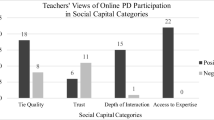Abstract
Asynchronous distance education can replicate traditional face-to-face training or education; but, why should it do so? Asynchronous distance education provides an opportunity to create meaningful learning which is not feasible in a traditional classroom, provided that communities of learners that encourage knowledge building and social reinforcement are specifically created. This article describes the need for learning communities within the context of asynchronous distance education. Asynchronous learning communities are specifically relevant for training environments, given the need for instant and constant training with employees who are located in an ever-expanding national and international workplace. Specifically, three types of communities are described: academic, intellectual and interpersonal.
Similar content being viewed by others
References
Ahern, T., Peck, K., & Laycock, M. (1992). The effects of teacher discourse in computer-mediated discussion.Journal of Educational Computing Research, 8(3).
Barry, M., & Runyan, G. (1995). A review of distance education studies in the U.S. military.American Journal of Distance Education, 9(3).
Brown A. (1994). The advancement of learning.Educational Researcher, 23(8).
Cairncross, F. (1997).The death of distance. Boston: Harvard Business School Press.
Cathcart, R., Samovar, L., & Henman, L. (1996).Small group communication: Theory and practice, (7th. Ed.). Madison: Brown and Benchmark.
Dillon, C., & Gunawardena, C. (1992). Evaluation research in distance education.British Journal of Education Technology, 23(3).
Garland, M. (1994). The adult need for “personal control” provides a cogent guiding principle for distance education.Journal of Distance Education, 9(1).
Garrison, D. (1990). An analysis and evaluation of audio teleconferencing to facilitate education at a a distance.American Journal of Distance Education, 4(3).
Gay, G. & Lentini, M. (1995). Use of communication resources in a networked collaborative design environment.Journal of Computer-Mediated Communication, 1(1).
Grabinger, R.S. (1996) Rich environments for active learning. In D.H. Jonassen (Ed.),The handbook of research for educational communications and technology (pp. 403–437). NY: Mcmillan.
Gunawardena. C. (1991). Current trends in the use of communications technologies for delivering distance education.International Journal of Instructional Media, 18(3).
Guzdial, M., Rappin, N., & Carlson, D. (1995). Collaborative and multimedia interactive learning environment for engineering education.Proceedings of the ACM Symposium on Applied Computing 1995 (pp. 5–9). Nashville, TN: ACM Press.
Hanson, D., Maushak, N., Schlosser, C., Anderson, M., Sorenson, C., & Simonson, M. (1996).Distance education: Review of the literature, 2nd Ed. Ames: Research Institute for Studies in Education.
Hillman, D., Willis, D., & Gunawardena, C. (1994). Learner interface interaction in distance education: an extension of contemporary models and strategies for practitioners.American Journal of Distance Education, 8(2).
Jegede, O., & Kirkwood, J. (1994). Student anxiety in learning through distance education.Distance Education, 15(2).
Jonassen, D.H. (1998). Designing constructivist learning environments. In C.M. Reigeluth (Ed.),Instructional design theories and models: Their current state of the art, 2nd Ed. Mahwah, NJ: Lawrence Erlbaum Associates.
Jonassen, D. & Reeves, T. (1996). Learning with technology, In D.H. Jonassen (Ed.),The handbook of research for educational communications and technology (pp. 403–437). NY: Mcmillan.
Kember, D., Lai, T., Murphy, D., Siaw, I., & Yuen, K. (1994). Student progress in distance education courses: A replication study.Adult Education Quarterly, 45(1).
Kember, D., Murphy, D., Siaw, I., & Yuen, K. (1991). Towards a causal model of student progress in distance education courses: research in Hong Kong.American Journal of Distance Education, 5(2).
Maslow, A. (1954).Motivation and personality. NY: Harper and Row.
McIsaac, M., & Gunawardena, C. (1996). Distance education. In D.H. Jonassen (Ed.),The handbook of research for educational communications and technology (pp. 403–437). NY: Mcmillan.
Moller, L. & Russell, J. (1994). An application the ARCS model confidence building strategies.Performance Improvement Quarterly.
Moore, M., & Kearsley, G. (1996).Distance education: A systems view. Belmont, CA: Wadsworth.
Neilson, R. (1997).Collaborative technologies & organizational learning. Hershey, PA: Idea Group.
O'Malley, C., & Scanlon, E. (1990). Computer-supported collaborative learning: problem solving and distance education.Computer Education 15(1).
Saba, F, & Shearer, R. (1994). Verifying key theoretical concepts in a dynamic model of distance education.American Journal Distance Education, 8(1).
Scardamalia, M., & Bereiter, C. (1994). Computer support for knowledge-building communities.The Journal of Learning Sciences, 3(3).
Woodruff, E. (1996).The effects of computer mediated communications on collaborative discourse in knowledge-building communities. Paper presented at American Educational Research Association.
Author information
Authors and Affiliations
Rights and permissions
About this article
Cite this article
Moller, L. Designing communities of learners for asynchronous distance education. ETR&D 46, 115–122 (1998). https://doi.org/10.1007/BF02299678
Issue Date:
DOI: https://doi.org/10.1007/BF02299678




